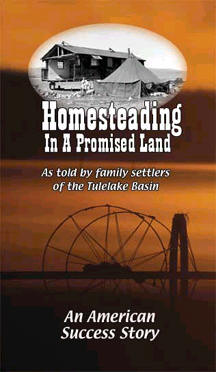|
Homesteading in
a Promised Land
This is a portion
of the film script for narration written by Mary
Palmer Nowland,
with material and contributions from Jacqui
Krizo, Marion Palmer and Bill Quinn
Also in the film, and not included
here, are interviews of over 24 settlers who tell
their story of settling the basin.

for more information
CLICK HERE |
A
new life, a fresh start. A pioneer’s dream.
As America’s centuries marched by, so did
the newcomers, driving their wagons west, over
the next rise, headed for the promised land.
The pioneers who moved across America carried
that hope in their bibles, in a locket around
their necks or packed in the back of the wagon.
Those that survived the distance went on, even
when all hope was lost.
Some people homesteaded parcels of land as they
went. Ranches began to spring up and farmers
tilled the soil. One of the last American
communities created Out West was in the Tule
Lake Basin near the California- Oregon border.
Tule Lake was a deep water lake held captive in
a high desert basin surrounded by volcanic
peaks. When the settlers arrived, they found a
harsh climate in a seemingly barren land.
The Reclamation Act of 1902 led to the Klamath
Project of 1906 which would enable 312,000 acres
of fertile land to be permanently irrigated for
farming. They built a system to drain and
reroute the water. As land became available when
water was diverted, people were encouraged to
homestead and begin farming. The first
homesteads were on the Westside because it was
drained off first.
|
Ancient peaks surround the basin in a caldera of
landmarks, anchoring the four directions:
Medicine Lake to the south, Wild Horse Peak to
the East, Sheepy Ridge on the West, Stukel
Mountain along the north side. The Peninsula and
Petroglyphs rise up in the center of the valley
as sentinels, silent witness to the long history
of Tule Lake. Each is suspended in a daily
series of shadows from the sunrises that span
across the basin floor to the sunsets. These
mountains have stood watch for centuries.
When the government gave a homestead to a
citizen, they were insured water rights. The
homesteaders paid back the Bureau of Reclamation
for the construction of the Klamath Project. It
was designed to aid the farmers in irrigation,
who then returned the water to the wildlife
refuge
A poor dirt road was plowed into the Medicine
Lake highlands and the homesteaders drove up for
a picnic and fishing or to hunt and camp,
building fire rings, and crude tables near the
swimming beach. The Lake is so deep it was
decades before technology allowed for a depth
measurement.
The volcanic eruptions from those highlands
molded lave tubes along the flanks, creating a
jagged lava blanket preserved today as The Lava
Beds National Monument. Some of the WWI
homesteaders worked at building trails and
ladders into the caves under the NRA program
during 1933-1934. At that time the park was
managed by the Forest Service and was later
taken over by the Park Service. The homesteaders
brought their families there to enjoy the
trails, caves, and wildlife. Hundreds of birds
and animals such as mule deer, mountain lion,
bald eagles, and rattlesnakes live amongst the
ancient juniper trees and sagebrush. Today, a
small band of wild horses still roam the back
country, their ancestors turned loose by the
settlers.
In spite of the vast assortment of recreational
choices in the area, vacations were few and far
between for the hard working families.
In 2001, the Federal Government shut off
irrigation water to the farms, parks,
cemeteries, and refuges. Water that was stored
for irrigation in the Klamath Project, paid for
by all of the farmers, was sent from the basin
to other parts of the region.
Characteristic of
the homesteaders and their community, they
pulled together and picked up the pieces. Four
generations of homesteaders and neighbors stood
side by side in their struggle to keep the
farmland, refuges, and the community intact.
What began with a simple idea of drawing names
out of a pickle jar, became a fine example of
what America stands for: live an honest life,
work the land, help your neighbor, love your
kids. The homesteaders are still hard at it
today, feeding the world and offering hope for a
better life.
copyright Mary
Palmer Nowland 2003
copyright Jacqui Krizo 2003
|
|

